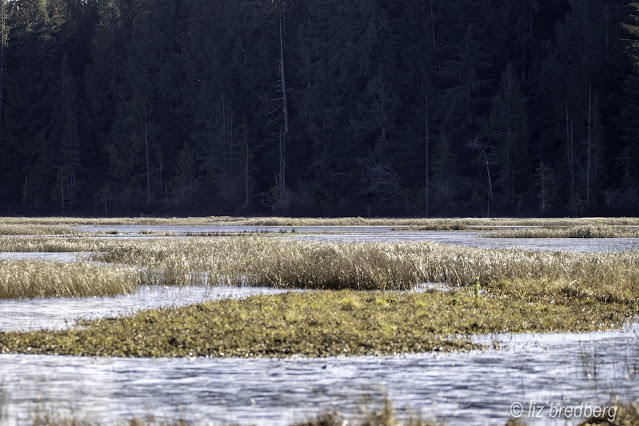11, 19 January
Two sunny days in the Forest and Wetlands.
After an unusually warm, wet season, we're now seeing days of brilliant sunshine, and chill air.
11 January
The 11th still saw abundant fungi, some rather mysterious.
Among the evergreen sword fern, dried bracken fern, and mosses, fungi emerge from downed branches.
Pink growth buds are beginning to appear on huckleberry bushes.
The moss critter (formerly Muppet) has sprouted fluffy ears.
What appears to be a toothed polypore is emerging from a downed alder.
An alder on the fringe of the Marsh is showing both catkins and cones as well as leaf buds. This seems early; again it had been a very mild winter until the 19th of this month, which may account for early growth.
After weeks obscured by cloud, Mount Arrowsmith is visible and snowy.
A small flock of buffleheads lined up at the south end of the Marsh.
19 January
Brilliant sun and hard frost this morning. The Forest often shows dramatic light effects, but this morning was exceptional.
Light renders small areas, such as this stump, brilliant.
Tiny mushrooms are singled out by the sun.
Beneath the smaller of these two, a bracken fern begins to sprout.
Coral fungus is turning blue as it ages.
This may be due to infection with an ascomytes fungus. In any case, it renders it inedible. Before it turns blue, it's edible although unpalatable.
The newly arrived cold weather has brought about the arrival of "hair ice," generally described as a rarity. It typically appears in broad-leaved forests, here, apparently exclusively alder.
These are filaments of ice about the circumference of hair, which have formed on downed wood. They appear in wood that is host to fungus of the genus Exidiopsis in which, according to research from the University of Bern,
[The] driving mechanism responsible for producing ice filaments at the wood surface is ice segregation. Liquid water near the branch surface freezes in contact with the cold air, creating an ice front and ‘sandwiching’ a thin water film between this ice and the wood pores. Suction resulting from repelling intermolecular forces acting at this ‘wood–water–ice sandwich’ then gets the water inside the wood pores to move towards the ice front, where it freezes and adds to the existing ice.
Hair ice has appeared to walkers in this area the past couple of days, when the mercury has fallen to a degree or two either side of 0 Celsius.
In addition to the hair ice, a growth of turkey tails appeared to have been frozen.
The Marsh had a skin of ice on its surface today.
A pair of trumpeter swans flew over, quietly, and an eruption of siskin burst from the foliage bordering the marsh.
A pair of hunters at the north end of the marsh were a much less welcome sight.
Fortunately, no waterfowl were visible to the hunters. Had we heard gunshots, we would have left the area, but it remained quiet. On enquiry with the Hamilton Wetlands and Forest Preservation Society and Mosaic Forest Management, we have learned that the area is closed to hunting. Mosaic has committed to replace missing "No Hunting" signs at the entrance of the area.






















Comments
Post a Comment